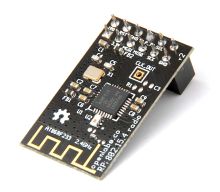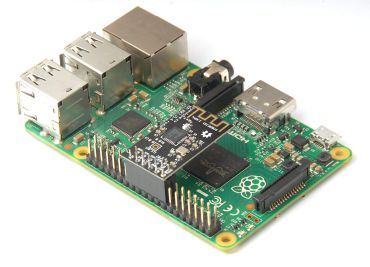Difference between revisions of "Raspberry Pi 3B+ 802.15.4/6LoWPAN Setup"
| Line 208: | Line 208: | ||
* https://comatrix.eu/setup/raspberry_pi_setup/ | * https://comatrix.eu/setup/raspberry_pi_setup/ | ||
* https://openlabs.co/store/Raspberry-Pi-802.15.4-radio | * https://openlabs.co/store/Raspberry-Pi-802.15.4-radio | ||
* [[RIOT-OS_and_IEEE_802.15.4_/_6LoWPAN]] | * [[RIOT-OS_and_IEEE_802.15.4_/_6LoWPAN|Wiki: RIOT-OS and IEEE 802.15.4 / 6LoWPAN]] | ||
=== Linux WPAN tools === | === Linux WPAN tools === | ||
Revision as of 13:44, 28 November 2023
Summary
Information on how to setup a Raspberry Pi 3B+ for 802.15.4 radio/6LoWPAN communication by utilizing an Openlabs 802.15.4 radio module.
This was tested successfully with Raspbian 10 (Buster) and Raspbian 11 (Bullseye). I assume it is also working on the latest Raspbian 12 (Bookworm).
Requirements
- Raspberry Pi 3B+ (Raspberry_Pi_3,_Model_B+,_WLAN,_BT)
- Operating system: Raspberry Pi OS (Raspbian)
- Openlabs 802.15.4 radio module: https://openlabs.co/store/Raspberry-Pi-802.15.4-radio
- Optional/alternatively (not tested): Raspberry Pi 6LoWPAN SLIP radio module
Setup/Config 802.15.4/6LoWPAN on a Raspberry
Install Raspbian on Raspberry Pi 3B+
- Use Raspberry Pi Imager
- Optional: Download Raspbian/Raspberry Pi OS from https://www.raspberrypi.com/software/operating-systems/
Preparation of Raspbian
Access the Raspberry Pi by attaching it via HDMI to a monitor. After enabling SSH it is possible to connect via SSH/terminal (default credentials are pi:raspberry).
- (Optionally) Change keyboard setting to "German" and reboot:
sudo dpkg-reconfigure keyboard-configuration
- Activate and start SSH on Raspberry:
sudo systemctl start ssh sudo systemctl enable ssh
- Upgrade of Raspbian:
sudo apt update && sudo apt upgrade
Enable support for IEEE 802.15.4/LoWPAN devices
- Plug the OpenLabs 802.15.4 radio module directly onto pins 15-26 of the Raspberry's P1 header (in the middle):
- There is an existing overlay for this transceiver shipped with Raspbian, should be in
/boot/overlays/at86rf233-overlay.dtbor/boot/overlays/at86rf233.dtbo:
ls /boot/overlays/at86rf233.dtbo
- Enable transceiver by modifying the
/boot/config.txtfile and reboot:
Installation of Linux WPAN tools
Sources/Links: see References:#Linux WPAN tools
- First install
gitand clone the wpan-tools Repository:
sudo apt install git sudo mkdir /opt/src sudo chown pi /opt/src cd /opt/src git clone https://github.com/linux-wpan/wpan-tools
- Install some required packages before building the wpan-tools:
sudo apt install dh-autoreconf libnl-3-dev libnl-genl-3-dev
- Configure, build and install wpan-tools:
cd /opt/src/wpan-tools ./autogen.sh ./configure CFLAGS='-g -O0' --prefix=/usr --sysconfdir=/etc --libdir=/usr/lib make sudo make install
- Verification/test of wpan-tools installation:
iwpan dev
MANUAL WPAN interface configuration
Sources/Links: see References:#WPAN interface configuration
- Configure the default PAN ID of RIOT-OS/SAMR21-xpro:
0x23 - Configure the default channel ID of RIOT-OS/SAMR21-xpro:
26
ip link set lowpan0 down ip link set wpan0 down iwpan phy phy0 set channel 0 26 # same network ID and channel as RIOT default iwpan dev wpan0 set pan_id 0x23 # same network ID and channel as RIOT default ip link add link wpan0 name lowpan0 type lowpan ip link set wpan0 up ip link set lowpan0 up
- Afterwards the
lowpan0interface on Raspberry has a link-local IPv6 address:
root@raspberrypi:~# ip a
1: lo: [...]
2: eth0: [...]
3: wlan0: [...]
4: wpan0: <BROADCAST,NOARP,UP,LOWER_UP> mtu 123 qdisc pfifo_fast state UNKNOWN group default qlen 300
link/ieee802.15.4 36:3a:07:cc:65:41:2b:31 brd ff:ff:ff:ff:ff:ff:ff:ff
5: lowpan0@wpan0: <BROADCAST,MULTICAST,UP,LOWER_UP> mtu 1280 qdisc noqueue state UNKNOWN group default qlen 1000
link/6lowpan 36:3a:07:cc:65:41:2b:31 brd ff:ff:ff:ff:ff:ff:ff:ff
inet6 fe80::343a:7cc:6541:2b31/64 scope link
valid_lft forever preferred_lft forever
NOTE/CAUTION: Every reboot changes the link-local IPv6 address of the lowpan0 interface on the Raspberry!
See #PERSISTENT wpan0 and lowpan0 configuration to configure a persistent link-local address.
There are also scripts available to create/delete a lowpan interface (or to create/delete a monitor interface): https://github.com/RIOT-Makers/wpan-raspbian
PERSISTENT wpan0 and lowpan0 configuration
With static long hardware address and static link-local IPv6 address (to avoid a random link-local IPv6 address on each reboot).
Sources/Links: see References:#Persistent WPAN interface configuration
- Clone riot-makers/wpan-raspbian GitHub repo:
cd /opt/src git clone https://github.com/riot-makers/wpan-raspbian cd wpan-raspbian
- Copy some helper (shell) scripts to a well-known location:
sudo cp -r usr/local/sbin/* /usr/local/sbin/. sudo chmod +x /usr/local/sbin/*
- Afterwards copy files for systemd integration:
sudo cp etc/default/lowpan /etc/default/. sudo cp etc/systemd/system/lowpan.service /etc/systemd/system/.
- Modify 802.15.4 channel ID and PAN ID in
/etc/default/lowpanas needed:
sudo nano /etc/default/lowpan CHN="13" PAN="0xbeef" # set MAC to "" for random mac/hw address MAC="02:0:0:0:0:0:0:1" # set IPv6 to "" if not required; note: set a prefix length #IP6="fdaa:bb:cc:dd::1/64" # Set ACK requests (Only enable if all devices on your PAN support ACKs) ACKREQ=0
Note: MAC="02:0:0:0:0:0:0:1" was taken from https://jan.newmarch.name/IoT/LinuxJournal/Routing/, this results in a link-local address of fe80::1 for the Raspberry.
- Enable
lowpan.serviceautostart, start 6LoWPAN service and verification:
sudo systemctl enable lowpan.service
sudo systemctl start lowpan.service
ifconfig
lowpan0: flags=4163<UP,BROADCAST,RUNNING,MULTICAST> mtu 1280
inet6 fe80::1 prefixlen 64 scopeid 0x20<link>
unspec 02-00-00-00-00-00-00-01-00-00-00-00-00-00-00-00 txqueuelen 1000 (UNSPEC)
RX packets 0 bytes 0 (0.0 B)
RX errors 0 dropped 0 overruns 0 frame 0
TX packets 19 bytes 2114 (2.0 KiB)
TX errors 0 dropped 0 overruns 0 carrier 0 collisions 0
wpan0: flags=195<UP,BROADCAST,RUNNING,NOARP> mtu 123
unspec 02-00-00-00-00-00-00-01-00-00-00-00-00-00-00-00 txqueuelen 300 (UNSPEC)
RX packets 72 bytes 2016 (1.9 KiB)
RX errors 0 dropped 0 overruns 0 frame 0
TX packets 74 bytes 5320 (5.1 KiB)
TX errors 0 dropped 0 overruns 0 carrier 0 collisions 0
Verification of 6LoWPAN connectivity between a Raspberry and a SAMR21-xpro
- Use RIOT's gnrc_networking example and build it for the SAMR21-xpro board, flash the firmware to the SAMR21-xpro and connect via
pyterm:
cd RIOT/examples/gnrc_networking make BOARD=samr21-xpro make BOARD=samr21-xpro flash make BOARD=samr21-xpro term
- Use
ifconfigto determine the 802.15.4/6LoWPAN interface ID of SAMR21-xpro (7in this case):
ifconfig # Iface 7 HWaddr: 57:98 Channel: 26 Page: 0 NID: 0x23 PHY: O-QPSK [...] # Long HWaddr: E2:F9:02:0F:36:26:A2:68 [...] # inet6 addr: fe80::e0f9:20f:3626:a268 scope: link VAL
- Note: All
ifconfigconfig options can be shown withifconfig <interface id> set.
- RIOT-OS default 802.15.4 channel is 26 and default PAN ID 0x23. If you change them, make sure to change them in the SAMR21-xpro configuration aswell:
- [optional] Change the channel to 13 and the PAN ID to 0xbeef (see RIOT-OS and IEEE 802.15.4 / 6LoWPAN for more information):
ifconfig 7 set pan_id 0xbeef ifconfig 7 set channel 13
TODO: Monitoring/Sniffing 802.15.4/6LoWPAN radio with a Raspberry =
Used Hardware
- Raspberry_Pi_3,_Model_B+,_WLAN,_BT
- https://openlabs.co/store/Raspberry-Pi-802.15.4-radio
- Optional/alternatively (not tested): Raspberry Pi 6LoWPAN SLIP radio module
- SAMR21-xpro: Atmel SAM R21 Xplained Pro Evaluation Platform
Courses
- IT-Security master's programme: Mobile and Embedded Security ILV
References
- https://comatrix.eu/setup/raspberry_pi_setup/
- https://openlabs.co/store/Raspberry-Pi-802.15.4-radio
- Wiki: RIOT-OS and IEEE 802.15.4 / 6LoWPAN
Linux WPAN tools
- https://github.com/RIOT-OS/RIOT/wiki/How-to-install-6LoWPAN-Linux-Kernel-on-Raspberry-Pi
- https://github.com/RIOT-Makers/wpan-raspbian/wiki/Create-a-generic-Raspbian-image-with-6LoWPAN-support
- https://github.com/RIOT-Makers/wpan-raspbian/wiki/Spice-up-Raspbian-for-the-IoT
WPAN interface configuration
- https://linux-wpan.org/documentation.html
- https://www.linuxjournal.com/content/low-power-wireless-6lowpan-ieee802154-and-raspberry-pi
- http://morschi.com/2017/04/05/hands-on-riot-6lowpan/

